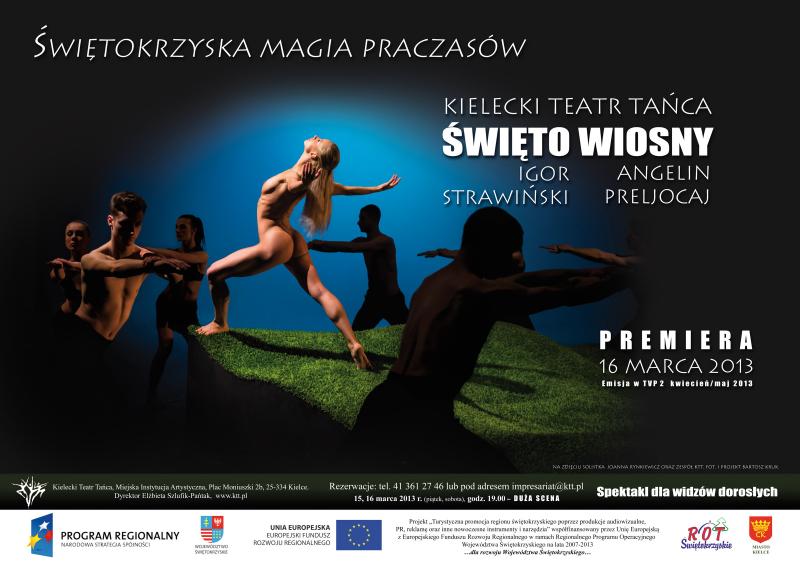
Fot. z materiałów TTZ.
The world premiere of The Rite of Spring in Angelin Preljocaj’s choreography took place in 2001. On 16 March 2013 the ballet will be staged for the first time in Poland, by the Kielce Dance Theatre, and recorded for national television. The ballet features 12 artists (6 female and 6 male dancers).
In her article Anna Królica wrote:
“In Angelin Preljocaj’s ballet the stage is made up of a hexagonal piece of grass-covered, rolling land, where the final sacrifice will take place. Its borders are guarded by dancers surrounding the Chosen One from all sides. She struggles to escape the ritual space where the killing is soon to happen. Yet the crowd prevails and the Chosen One is stripped of her clothing. Ashamed of her nakedness, the victim girl tries to hide in the grass. However, next moment, she stands up with determination and takes another effort to break away from the circle. With subsequent scenes the rite nears its inevitable close. Before this will happen, the Chosen One is subjected to ritual gang rape. She does not cease to fight. The final scene brings an unexpected change: the girl lies herself calmly on the warm grass and – in a newly made covenant with nature – waits. Her painfully flexed muscles relax, as if she wants to fall asleep. Her manner is full of trusting confidence. The fear and exhaustion are gone”.
“Such explicit scenes of violence are not present in previous choreographies. Also new is the contrast between the lack of connection with another human being and the strong link with nature. It might seem that this wilderness and abruptness of movement, fuelled by the music, will always be the emblem of The Rite: ecstatic dancing, short rhythmic steps, bodies arched in copulative poses, jolts and jerks. Still, it is only yet another phantasm.”
Read more of the ballet’s analysis:Anna Królica, Święto wiosny. Powracający gest choreografów, „dwutygodnik.com”
http://www.dwutygodnik.com/artykul/1012-swieto-wiosny-powracajacy-gest-choreografow.html
***
The world premiere of The Rite of Spring (Paris, 1913) set to the music of Igor Stravinsky and choreographed by Vatslav Nijinsky provoked one of the biggest scandals in musical history. Every element of the ballet was repulsive to contemporary tastes. It was the subject matter that made Stravinsky apply new, previously unknown, means of expression. The pagan rite depicted was barbarian, wild, and such was the music composed for the ballet. In The Rite rhythmics took on a new significance: it came to the fore as the element which shapes and develops the musical conception. This was complemented with sharp sounding instrumentation and dissonances. The choreography and movement conception also needed novel solutions: sharp, abrupt movements along with certain ponderousness to underscore inevitability and submission. This task was met by the choreographer with particular accuracy and poignancy.
The Rite of Spring is a very special work, possessing extreme power of influence on the audience. This is probably why the ballet is continuously re-explored by noted choreographers, such as Pina Bausch, or Maurice Bejart. Its archetypical depth provides extraordinary space for artistic interpretation. The ballet’s leading motif is a pagan celebration of spring in the process of which a sacrifice is made as part of a rite of nature’s revival. Inevitability, power and powerlessness create an axis for a dramatic story of faith, fear and strength to unfold.